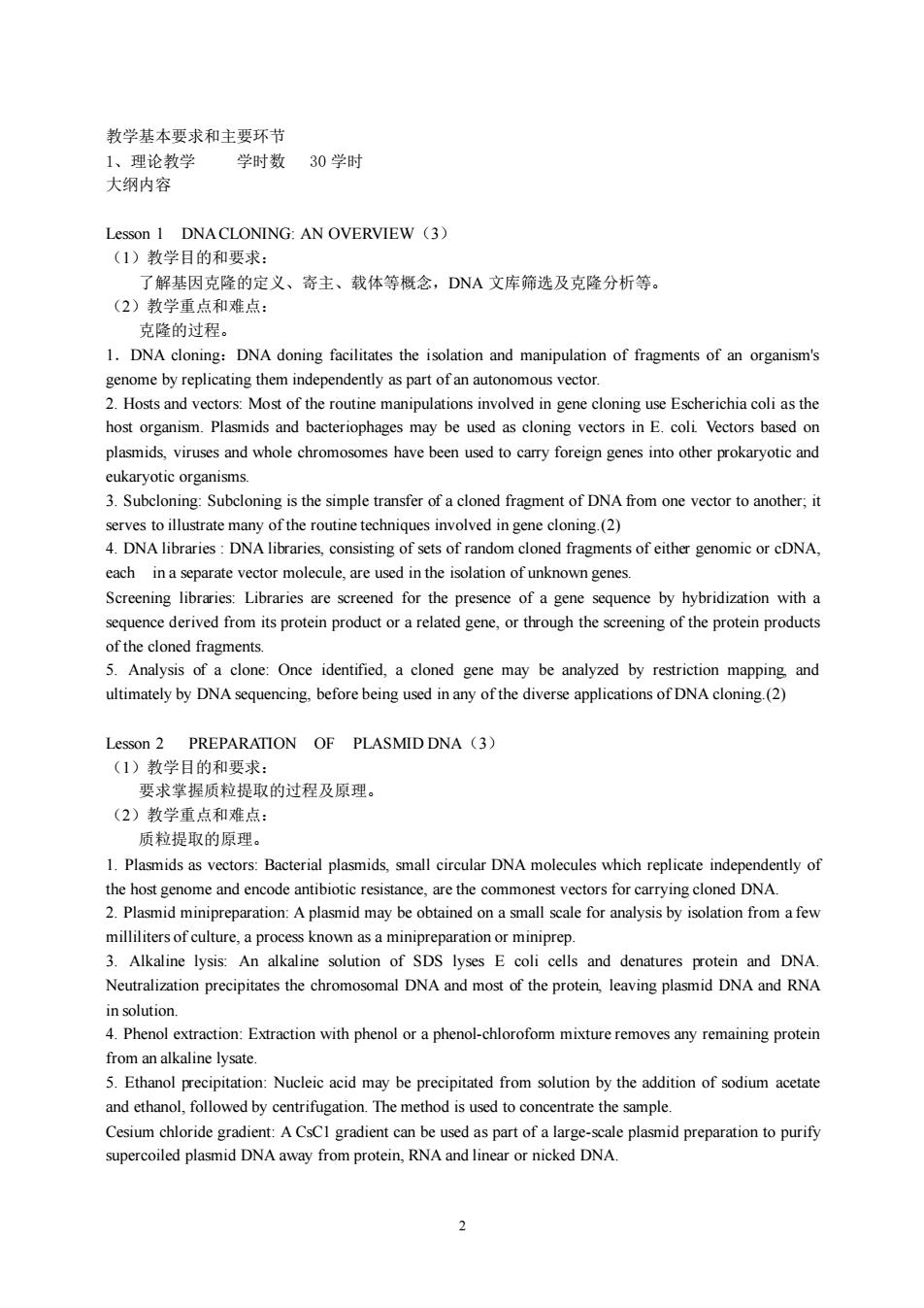正在加载图片...

教学基本要求和主要环节 1、理论教学 学时数30学时 大纲内容 Lesson I DNACLONING:AN OVERVIEW (3) (1)教学目的和要求: 了解基因克隆的定义、寄主、载体等概念,DNA文库筛选及克隆分析等 (2) 克隆的过程。 1.DNA cloning:DNA doning facilitates the isolation and manipulation of fragments of an organism's genome by replicating them independently as part of an autonomous vector. host organism.Plasmids and bacteriophage may be used as clonin vectors in E.coli Vectors based on plasmids,viruses and whole chromosomes have been used to carry foreign genes into other prokaryotic and eukaryotic organisms. 3.Subcloning:Subcloning is the simple transfer of a cloned fragment of DNA from one vector to another;it serves to illustrate many of the routine technigues involved in gene cloning (2) 4.DNA:.consisting of sets of random coned fragments of the nomic or cDNA. each in a separate vector molecule,are us in the isolation of unknown genes Screening libraries:Libraries are screened for the presence of a gene sequence by hybridization with a sequence derived from its protein product or a related gene,or through the screening of the protein products of the cloned fragments 5.Analysis of a clone:Once identified,a cloned gene may be analyzed by restriction mapping and uimately by before being usd nany ofthe divers applications of( Lesson 2 PREPARATION OF PLASMID DNA(3) (1)教学目的和要求: 要求掌握质粒提取的过程及原理。 (2)教学重占和难占 质粒提取的原理。 1.Plasmids as vectors:Bacterial plasmids,small circular DNA molecules which replicate independently of the host genome and encode antibiotic resistance,are the commonest vectors for carrying cloned DNA. 2.Plasmid minipreparation:A plasmid may be obtained on a small scale for analysis by isolation from a few milliliters of culture,a process known as a minip reparation r miniprep. 3 Alkaline lysis: alkalin solution of SDS lyses Ecoli cells and denatures protein and DNA Neutralization precipitates the chromosomal DNA and most of the protein,leaving plasmid DNA and RNA in solution. 4.Phenol extraction:Extraction with phenol or a phenol-chlorofom mixture removes any remaining protein from an alkaline lysate. and ethano,followed by centrifugation.The method is used toconcentrate the sample Cesium chloride gradient:A CsCI gradient can be used as part of a large-scale plasmid preparation to purify supercoiled plasmid DNA away from protein,RNA and linear or nicked DNA. 2 教学基本要求和主要环节 1、理论教学 学时数 30 学时 大纲内容 Lesson 1 DNA CLONING: AN OVERVIEW(3) (1)教学目的和要求: 了解基因克隆的定义、寄主、载体等概念,DNA 文库筛选及克隆分析等。 (2)教学重点和难点: 克隆的过程。 1.DNA cloning:DNA doning facilitates the isolation and manipulation of fragments of an organism's genome by replicating them independently as part of an autonomous vector. 2. Hosts and vectors: Most of the routine manipulations involved in gene cloning use Escherichia coli as the host organism. Plasmids and bacteriophages may be used as cloning vectors in E. coli. Vectors based on plasmids, viruses and whole chromosomes have been used to carry foreign genes into other prokaryotic and eukaryotic organisms. 3. Subcloning: Subcloning is the simple transfer of a cloned fragment of DNA from one vector to another; it serves to illustrate many of the routine techniques involved in gene cloning.(2) 4. DNA libraries : DNA libraries, consisting of sets of random cloned fragments of either genomic or cDNA, each in a separate vector molecule, are used in the isolation of unknown genes. Screening libraries: Libraries are screened for the presence of a gene sequence by hybridization with a sequence derived from its protein product or a related gene, or through the screening of the protein products of the cloned fragments. 5. Analysis of a clone: Once identified, a cloned gene may be analyzed by restriction mapping, and ultimately by DNA sequencing, before being used in any of the diverse applications of DNA cloning.(2) Lesson 2 PREPARATION OF PLASMID DNA(3) (1)教学目的和要求: 要求掌握质粒提取的过程及原理。 (2)教学重点和难点: 质粒提取的原理。 1. Plasmids as vectors: Bacterial plasmids, small circular DNA molecules which replicate independently of the host genome and encode antibiotic resistance, are the commonest vectors for carrying cloned DNA. 2. Plasmid minipreparation: A plasmid may be obtained on a small scale for analysis by isolation from a few milliliters of culture, a process known as a minipreparation or miniprep. 3. Alkaline lysis: An alkaline solution of SDS lyses E coli cells and denatures protein and DNA. Neutralization precipitates the chromosomal DNA and most of the protein, leaving plasmid DNA and RNA in solution. 4. Phenol extraction: Extraction with phenol or a phenol-chloroform mixture removes any remaining protein from an alkaline lysate. 5. Ethanol precipitation: Nucleic acid may be precipitated from solution by the addition of sodium acetate and ethanol, followed by centrifugation. The method is used to concentrate the sample. Cesium chloride gradient: A CsC1 gradient can be used as part of a large-scale plasmid preparation to purify supercoiled plasmid DNA away from protein, RNA and linear or nicked DNA